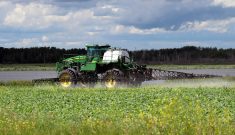During my long tenure with Alberta Agriculture we, as a crop protection unit, produced many farmer information presentations, fact sheets, books, booklets, broadcasts and seminars.
From 2000 onward, Alberta Agriculture severely cut down on this and other farm information units. The books and fact sheets are fully relevant today but they need upgrading and maintenance, in a few instances, so they can remain available and useful to the farming industry.
Take for example the Alberta Blue Book, also known as the Alberta Crop Protection Guide. This book was developed in the 1980s as a comprehensive guide to available herbicides, fungicides and insecticides. I was responsible for the fungicide and seed treatment section. The Blue Book was a roaring success and soon there was a joint Manitoba/Saskatchewan version, now produced as separate entities.
Read Also

Claas brings 1000 Series SP forage harvesters to Canada
In mid-August, Claas unveiled its new line of Jaguar forage harvesters at an event in Visalia, California, deep in the heart of that state’s dairy region.
Despite that success, Alberta Agriculture dropped its annual production. Fortunately, it was promptly taken over by Alberta’s crop commissions and you can purchase a copy online for around $15. The Saskatchewan edition, the Guide to Crop Protection, is available for free at agricultural extension offices and farm gatherings. The updated 2024 text can be obtained by calling 1-866-457-2377 in Saskatchewan.
The Manitoba version, the Guide to Field Crop Production, is available at provincial ag service centres at $10 per copy.
All three publications are updated annually and are excellent texts to have on hand. It is easier to pick up any of these and look up the pesticide you may have applied during the current growing season or the previous year.
The more you know
I could list dozens of textbooks, let alone fact sheets, but I will list and describe only a few. In the mid-1970s, none of these farmer information textbooks existed and weed, disease and insect control were virtually matters of word of mouth.
In 1975, I was looking at an information sheet on sclerotinia in canola and to my surprise, it said sclerotinia infection was a result of broken pieces of fungal hyphae bounced up from the soil surface by rainstorms. The first canola field I visited was heavily damaged by sclerotinia in late July 1975 at Stony Plain, Alta. Within a few steps into the diseased crop, there were dozens of tiny fungal apothecia (mushrooms) in every square foot or so of cropland.
It seems no one in North America had bothered to look for overwintered sclerotes in the field. This Stony Plain field had dozens of visitors from many areas of the Prairies who finally began to better understand this destructive disease.
As a consequence of this and other field crop diseases in Canada, I linked up with Lloyd Edgington at the University of Guelph and Lloyd Seaman at Ottawa. We agreed at a meeting of the Canadian Phytopathological Society to compile a textbook in English and French on significant diseases of field crops in Canada.
By 1984, under the editorship of Lloyd Seaman, W.J. Martins and T.G Atkinson, co-operation from coast to coast produced our 160-page colour illustrated text, Diseases of Field Crops in Canada. Sales in the $30 range were brisk on the Prairies, outstripping the rest of the country combined.
This book has been revised twice, with a third edition on the way. Much of the financing for the third edition came from the agrochemical and seed technology industries. Copies can be obtained from Discovery Seed Labs in Saskatoon at 306-249-4484 at $35 each.
If you are into horticulture or potatoes, you need to look up Diseases and Pests of Vegetable Crops in Canada. The chief editor was Ron Howard at Alberta Agriculture at Brooks. Howard and many others did a fantastic job of describing the significant pests and diseases of horticultural crops from coast to coast. This book is a free download on the internet and is an absolute must for potato growers as well as those of every horticultural crop.
There are many books, booklets and fact sheets available to growers on the internet. Just because you can install an app on your phone, do not think you have all the answers on hand. If, for example, you are an organic grower, Alberta Agriculture published a book called Practical Crop Protection on weeds, insects and disease. The 170-page text is non-chemical and though it was published in 1993, it warned against the damages of clubroot in canola well before its discovery in 2003.
Such books and fact sheets may vanish with the onset of technology, but having them on hand or revising their content and keeping them current online for the farming community could help ward off insect, weed or disease problems before they become endemic.
















